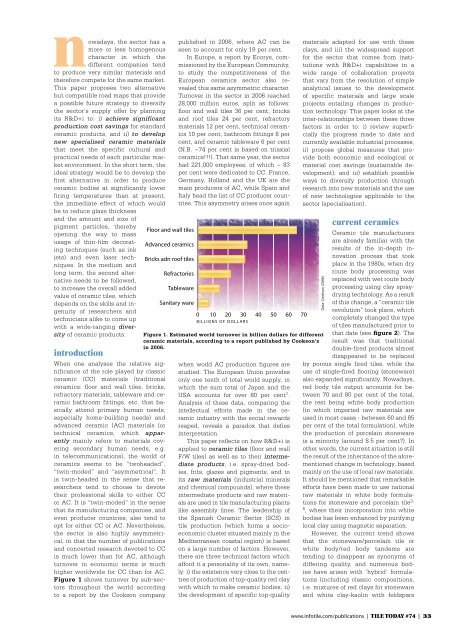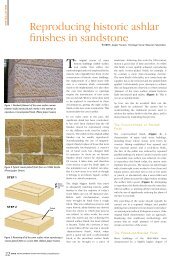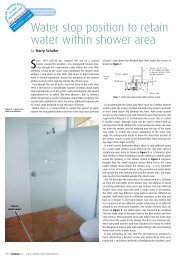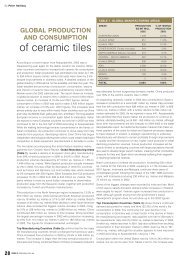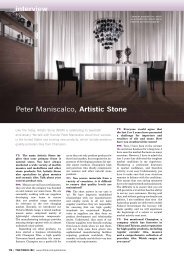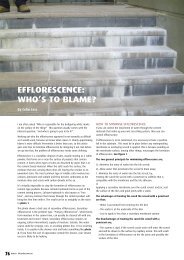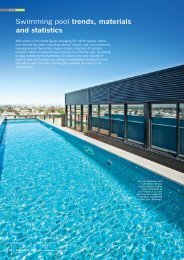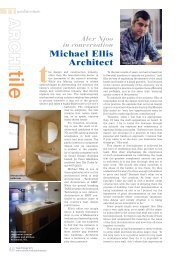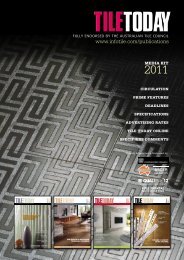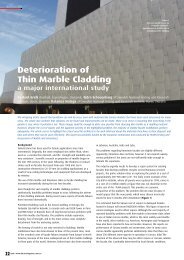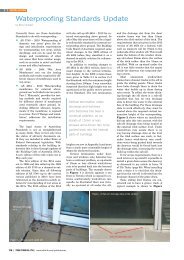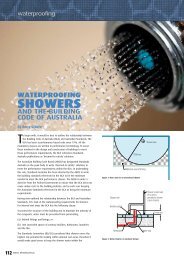Research & Development for Ceramic Tiles in the 21st ... - Infotile
Research & Development for Ceramic Tiles in the 21st ... - Infotile
Research & Development for Ceramic Tiles in the 21st ... - Infotile
Create successful ePaper yourself
Turn your PDF publications into a flip-book with our unique Google optimized e-Paper software.
nowadays, <strong>the</strong> sector has a<br />
more or less homogenous<br />
character <strong>in</strong> which <strong>the</strong><br />
different companies tend<br />
to produce very similar materials and<br />
<strong>the</strong>re<strong>for</strong>e compete <strong>for</strong> <strong>the</strong> same market.<br />
This paper proposes two alternative<br />
but compatible road maps that provide<br />
a possible future strategy to diversify<br />
<strong>the</strong> sector’s supply offer by plann<strong>in</strong>g<br />
its R&D+i to: i) achieve significant<br />
production cost sav<strong>in</strong>gs <strong>for</strong> standard<br />
ceramic products, and ii) to develop<br />
new specialised ceramic materials<br />
that meet <strong>the</strong> specific cultural and<br />
practical needs of each particular market<br />
environment. In <strong>the</strong> short term, <strong>the</strong><br />
ideal strategy would be to develop <strong>the</strong><br />
first alternative <strong>in</strong> order to produce<br />
ceramic bodies at significantly lower<br />
fir<strong>in</strong>g temperatures than at present,<br />
<strong>the</strong> immediate effect of which would<br />
be to reduce glaze thickness<br />
and <strong>the</strong> amount and size of<br />
pigment particles, <strong>the</strong>reby<br />
open<strong>in</strong>g <strong>the</strong> way to mass<br />
usage of th<strong>in</strong>-film decorat<strong>in</strong>g<br />
techniques (such as <strong>in</strong>k<br />
jets) and even laser techniques.<br />
In <strong>the</strong> medium and<br />
long term, <strong>the</strong> second alternative<br />
needs to be followed,<br />
to <strong>in</strong>crease <strong>the</strong> overall added<br />
value of ceramic tiles, which<br />
depends on <strong>the</strong> skills and <strong>in</strong>genuity<br />
of researchers and<br />
technicians alike to come up<br />
with a wide-rang<strong>in</strong>g diversity<br />
of ceramic products.<br />
<strong>in</strong>troduction<br />
When one analyses <strong>the</strong> relative significance<br />
of <strong>the</strong> role played by classic<br />
ceramic (CC) materials (traditional<br />
ceramics: floor and wall tiles, bricks,<br />
refractory materials, tableware and ceramic<br />
bathroom fitt<strong>in</strong>gs, etc. that basically<br />
attend primary human needs,<br />
especially home-build<strong>in</strong>g needs) and<br />
advanced ceramic (AC) materials (or<br />
technical ceramics, which apparently<br />
ma<strong>in</strong>ly refers to materials cover<strong>in</strong>g<br />
secondary human needs, e.g.<br />
<strong>in</strong> telecommunications), <strong>the</strong> world of<br />
ceramics seems to be “two headed”,<br />
“tw<strong>in</strong>-moded” and “asymmetrical”. It<br />
is tw<strong>in</strong>-headed <strong>in</strong> <strong>the</strong> sense that researchers<br />
tend to choose to devote<br />
<strong>the</strong>ir professional skills to ei<strong>the</strong>r CC<br />
or AC. It is “tw<strong>in</strong>-moded” <strong>in</strong> <strong>the</strong> sense<br />
that its manufactur<strong>in</strong>g companies, and<br />
even producer countries, also tend to<br />
opt <strong>for</strong> ei<strong>the</strong>r CC or AC. Never<strong>the</strong>less,<br />
<strong>the</strong> sector is also highly asymmetrical,<br />
<strong>in</strong> that <strong>the</strong> number of publications<br />
and concerted research devoted to CC<br />
is much lower than <strong>for</strong> AC, although<br />
turnover <strong>in</strong> economic terms is much<br />
higher worldwide <strong>for</strong> CC than <strong>for</strong> AC.<br />
Figure 1 shows turnover by sub-sectors<br />
throughout <strong>the</strong> world accord<strong>in</strong>g<br />
to a report by <strong>the</strong> Cookson company<br />
Floor and wall tiles<br />
Advanced ceramics<br />
Bricks adn roof tiles<br />
published <strong>in</strong> 2006, where AC can be<br />
seen to account <strong>for</strong> only 19 per cent.<br />
In Europe, a report by Ecorys, commissioned<br />
by <strong>the</strong> European Community,<br />
to study <strong>the</strong> competitiveness of <strong>the</strong><br />
European ceramics sector also revealed<br />
this same asymmetric character.<br />
Turnover <strong>in</strong> <strong>the</strong> sector <strong>in</strong> 2006 reached<br />
28,000 million euros, split as follows:<br />
floor and wall tiles 36 per cent, bricks<br />
and roof tiles 24 per cent, refractory<br />
materials 12 per cent, technical ceramics<br />
10 per cent, bathroom fitt<strong>in</strong>gs 8 per<br />
cent, and ceramic tableware 6 per cent<br />
(N.B. ~74 per cent is based on triaxial<br />
ceramics!!!). That same year, <strong>the</strong> sector<br />
had 221,000 employees, of which ~ 83<br />
per cent were dedicated to CC. France,<br />
Germany, Holland and <strong>the</strong> UK are <strong>the</strong><br />
ma<strong>in</strong> producers of AC, while Spa<strong>in</strong> and<br />
Italy head <strong>the</strong> list of CC producer countries.<br />
This asymmetry arises once aga<strong>in</strong><br />
Refractories<br />
Tableware<br />
Sanitary ware<br />
0 10 20 30 40 50 60 70<br />
BILLIONS OF DOLLARS<br />
Figure 1. Estimated world turnover <strong>in</strong> billion dollars <strong>for</strong> different<br />
ceramic materials, accord<strong>in</strong>g to a report published by Cookson’s<br />
<strong>in</strong> 2006.<br />
when world AC production figures are<br />
studied. The European Union provides<br />
only one tenth of total world supply, <strong>in</strong><br />
which <strong>the</strong> sum total of Japan and <strong>the</strong><br />
USA accounts <strong>for</strong> over 80 per cent 1 .<br />
Analysis of <strong>the</strong>se data, compar<strong>in</strong>g <strong>the</strong><br />
<strong>in</strong>tellectual ef<strong>for</strong>ts made <strong>in</strong> <strong>the</strong> ceramic<br />
<strong>in</strong>dustry with <strong>the</strong> social rewards<br />
reaped, reveals a paradox that defies<br />
<strong>in</strong>terpretation.<br />
This paper reflects on how R&D+i is<br />
applied to ceramic tiles (floor and wall<br />
F/W tiles) as well as to <strong>the</strong>ir <strong>in</strong>termediate<br />
products, i.e. spray-dried bodies,<br />
frits, glazes and pigments, and to<br />
its raw materials (<strong>in</strong>dustrial m<strong>in</strong>erals<br />
and chemical compounds), where <strong>the</strong>se<br />
<strong>in</strong>termediate products and raw materials<br />
are used <strong>in</strong> tile manufactur<strong>in</strong>g plants<br />
like assembly l<strong>in</strong>es. The leadership of<br />
<strong>the</strong> Spanish <strong>Ceramic</strong> Sector (SCS) <strong>in</strong><br />
tile production (which <strong>for</strong>ms a socioeconomic<br />
cluster situated ma<strong>in</strong>ly <strong>in</strong> <strong>the</strong><br />
Mediterranean coastal region) is based<br />
on a large number of factors. However,<br />
<strong>the</strong>re are three technical factors which<br />
af<strong>for</strong>d it a personality of its own, namely:<br />
i) <strong>the</strong> existence very close to <strong>the</strong> centres<br />
of production of top-quality red clay<br />
with which to make ceramic bodies, ii)<br />
<strong>the</strong> development of specific top-quality<br />
materials adapted <strong>for</strong> use with <strong>the</strong>se<br />
clays, and iii) <strong>the</strong> widespread support<br />
<strong>for</strong> <strong>the</strong> sector that comes from <strong>in</strong>stitutions<br />
with R&D+i capabilities <strong>in</strong> a<br />
wide range of collaboration projects<br />
that vary from <strong>the</strong> resolution of simple<br />
analytical issues to <strong>the</strong> development<br />
of specific materials and large scale<br />
projects entail<strong>in</strong>g changes <strong>in</strong> production<br />
technology. This paper looks at <strong>the</strong><br />
<strong>in</strong>ter-relationships between <strong>the</strong>se three<br />
factors <strong>in</strong> order to: i) review superficially<br />
<strong>the</strong> progress made to date and<br />
currently available <strong>in</strong>dustrial processes,<br />
ii) propose global measures that provide<br />
both economic and ecological or<br />
material cost sav<strong>in</strong>gs (susta<strong>in</strong>able development);<br />
and iii) establish possible<br />
ways to diversify production through<br />
research <strong>in</strong>to new materials and <strong>the</strong> use<br />
of new technologies applicable to <strong>the</strong><br />
sector (specialisation).<br />
Data: Cookson (2006)<br />
current ceramics<br />
<strong>Ceramic</strong> tile manufacturers<br />
are already familiar with <strong>the</strong><br />
results of <strong>the</strong> <strong>in</strong>-depth <strong>in</strong>novation<br />
process that took<br />
place <strong>in</strong> <strong>the</strong> 1980s, when dry<br />
route body process<strong>in</strong>g was<br />
replaced with wet route body<br />
process<strong>in</strong>g us<strong>in</strong>g clay spraydry<strong>in</strong>g<br />
technology. As a result<br />
of this change, a “ceramic tile<br />
revolution” took place, which<br />
completely changed <strong>the</strong> type<br />
of tiles manufactured prior to<br />
that date (see figure 2). The<br />
result was that traditional<br />
double-fired products almost<br />
disappeared to be replaced<br />
by porous s<strong>in</strong>gle fired tiles, while <strong>the</strong><br />
use of s<strong>in</strong>gle-fired floor<strong>in</strong>g (stoneware)<br />
also expanded significantly. Nowadays,<br />
red body tile output accounts <strong>for</strong> between<br />
70 and 80 per cent of <strong>the</strong> total,<br />
<strong>the</strong> rest be<strong>in</strong>g white body production<br />
(<strong>in</strong> which imported raw materials are<br />
used <strong>in</strong> most cases - between 60 and 85<br />
per cent of <strong>the</strong> total <strong>for</strong>mulation), while<br />
<strong>the</strong> production of porcela<strong>in</strong> stoneware<br />
is a m<strong>in</strong>ority (around 8.5 per cent). In<br />
o<strong>the</strong>r words, <strong>the</strong> current situation is still<br />
<strong>the</strong> result of <strong>the</strong> <strong>in</strong>heritance of <strong>the</strong> a<strong>for</strong>ementioned<br />
change <strong>in</strong> technology, based<br />
ma<strong>in</strong>ly on <strong>the</strong> use of local raw materials.<br />
It should be mentioned that remarkable<br />
ef<strong>for</strong>ts have been made to use national<br />
raw materials <strong>in</strong> white body <strong>for</strong>mulations<br />
<strong>for</strong> stoneware and porcela<strong>in</strong> tile 2-<br />
6 , where <strong>the</strong>ir <strong>in</strong>corporation <strong>in</strong>to white<br />
bodies has been enhanced by purify<strong>in</strong>g<br />
local clay us<strong>in</strong>g magnetic separation.<br />
However, <strong>the</strong> current trend shows<br />
that <strong>the</strong> stoneware/porcela<strong>in</strong> tile or<br />
white body/red body tandems are<br />
tend<strong>in</strong>g to disappear as synonyms of<br />
differ<strong>in</strong>g quality, and numerous bodies<br />
have arisen with ‘hybrid’ <strong>for</strong>mulations<br />
(<strong>in</strong>clud<strong>in</strong>g classic compositions,<br />
i.e. mixtures of red clays <strong>for</strong> stoneware<br />
and white clay-kaol<strong>in</strong> with feldspars<br />
www.<strong>in</strong>fotile.com/publications | Tile Today #74 | 33


